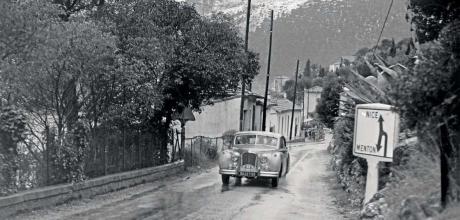A Jaguar Mk VII finishes fourth at the 1952 Monte Carlo Rally
Cecil ward’s amazing third place in 1951’s long and arduous Monte Carlo Rally driving a Mk V proved that Jaguar’s big saloons had what it took to compete at the highest level. The newer Mk VII was a better candidate, though. Marcel Becquart, who had won the 1950 Monte Carlo Rally in a Hotchkiss, approached Jaguar’s competition’s manager, Lofty England, at the Paris Motor Show in autumn 1951 about using a Mk VII for the following year’s Monte. Not wanting to directly take part in the rally, Jaguar declined, although others did use the big saloon, some more successfully than others.
The most famous was Ian Appleyard and his co-driving wife, Pat. But, despite winning the 1950 and 1951 Alpine Rally in their works-prepared XK 120 (NUB 120), they found success on the 1952Monte hard to find. Setting out from Glasgow in their Mk VII (registered PNW7), they encountered harsh weather conditions through central France that hindered their progress, finishing a lowly 53rd.Motor Sport magazine reported in its March 1952 issue, “Ace rally-man Ian Appleyard just couldn’t see his way through the blizzard.” The pair went on to redeem themselves the following year, using the same car to finish second.
Another Mk VII, driven by the British pairing of WH Wadham and WH Waring, fared even worse, scraping in at 156th after getting stuck in ice. They did, however, win the Concours de Confort in the big car class, awarded for both style and luxury.
It wasn’t all bad news for Jaguar in the rally, because Frenchman René Cotton finished just off the podium in his own Mk VII. Born on 19 February 1914, in Sainte-Colombe, a few miles south of Lyon in eastern France, Cotton’s first taste of competition was as a downhill skier during the Thirties. He was introduced to motor racing by the French driver Jean-Pierre Wimille, whose wife he had just taught to ski. Cotton’s first motorsport event was the 1950 Dauphine Rally, driving a Citroën Traction Avant. Despite favouring French cars throughout his career, for reasons unknown, he chose a Jaguar Mk VII (registration 5922 Y69) for the 1952 Monte Carlo Rally.
Along with the other South European competitors, Cotton and his co-driver, L Didier, started from Lisbon, in Portugal, meaning that they crossed France’s Massif Central before the terrible weather that hampered the Glasgow group took hold. By reaching the Monte Carlo finish line without picking up any penalty points, Cotton and Didier took a fine fourth place, two ahead of another French-entered Mk VII, that of Jean Heurtaux.
Cotton entered one more event with the Mk VII, the Alpine Rally in July 1952, from which he was forced to retire. He would later race at Le Mans (five times between 1953 and 1959) and start his own team, Ecurie-Paris-Île-de-France, in 1958, before becoming head of Citroën’s competition department five years later. Although Cotton’s fourth place is now a footnote of Jaguar’s long and successful racing history, it proved the Mk VII’s capability, and paved the way for even greater things on the Monte Carlo Rally, culminating with an outright win in 1956 at the hands of an Irish driver, Ronnie Adams.


